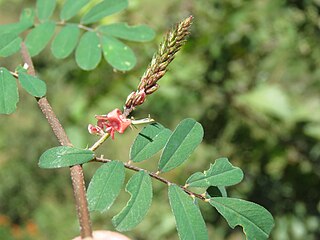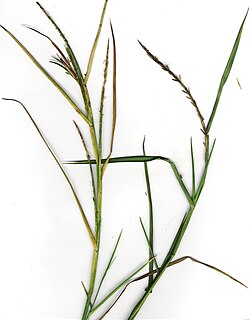
Forage is a plant material eaten by grazing livestock. Historically, the term forage has meant only plants eaten by the animals directly as pasture, crop residue, or immature cereal crops, but it is also used more loosely to include similar plants cut for fodder and carried to the animals, especially as hay or silage.

Corn stover consists of the leaves, stalks, and cobs of maize (corn) plants left in a field after harvest. Such stover makes up about half of the yield of a corn crop and is similar to straw from other cereal grasses; in Britain it is sometimes called corn straw. Corn stover is a very common agricultural product in areas of large amounts of corn production. As well as the non-grain part of harvested corn, the stover can also contain other weeds and grasses. Field corn and sweet corn, two different types of maize, have relatively similar corn stover.

Chloris gayana is a species of grass known by the common name Rhodes grass. It is native to Africa but it can be found throughout the tropical and subtropical world as a naturalized species.

Stylosanthes is a genus of flowering plants in the legume family, Fabaceae and contains numerous highly important pasture and forage species. It was recently assigned to the informal monophyletic Pterocarpus clade of the Dalbergieae. The common name pencilflower is sometimes used for plants in this genus.

Arachis pintoi is a forage plant native to Cerrado vegetation in Brazil. It is native to the valleys of the upper São Francisco and the Jequitinhonha rivers of Minas Gerais. It has been named after the Brazilian botanist Geraldo Pinto, who first collected the plant at the locality of Boca do Córrego, município de Belmonte in 1954 and suggested its potential as a forage. The species has been first described by A. Krapovickas and W. Gregory in 1994.
Bela "Bert" Grof was a Hungarian-born Australian agricultural researcher with contributions to grassland and forage research in the tropics.

Urochloa brizantha is a species of grass known by the common name palisade grass. It is often used as a forage for livestock.

Dichanthium annulatum is a species of grass. It is commonly used as a forage for livestock.

Digitaria didactyla is a species of grass known by the common names blue couch, Queensland blue couch, blue serangoon grass, green serangoon grass, blue stargrass, and petit gazon. It is native to Mauritius, Réunion, parts of mainland Africa, and Madagascar. It has been introduced widely outside its native range, mainly for use as a pasture and turf grass. It has naturalized in some regions.
Brachiaria ruziziensis or Congo grass is a forage crop that is grown throughout the humid tropics. With fast growth at the beginning of the wet season due to strong seedling vigour, ease of establishment, good seed production and yield and the ability to suppress weeds it has the ability to become developed into the most important forage crop planted in the tropics. With the aid of genomic tools to research the genotype and gain more information there is the ability to increase breeding programs which are currently rather limited.

Indigofera hirsuta, the hairy indigo or rough hairy indigo, is a species of flowering plant in the family Fabaceae. It is native to nearly all the world's tropics; South America, Africa, Madagascar, the Indian Subcontinent, southern China, southeast Asia, Malesia, Papuasia and Australia, and has been introduced to the Caribbean, the southeast United States, Mexico and Central America. It is used as a green manure and, to a minor extent, for forage.

Grewia bicolor, called bastard brandy bush, false brandy bush, two-coloured grewia, white-leaved grewia, white-leaved raisin, white raisin and donkey berry, is a species of flowering plant in the family Malvaceae, native to Sub‑Saharan Africa, Yemen, Oman, and the Indian Subcontinent. In Africa Grewia bicolor is one of the most important forages during the dry season, when all herbivores, wild and domestic, find it palatable. It is particularly enjoyed by giant eland and domestic goats.

Indigofera hendecaphylla, the creeping indigo or trailing indigo, is a species of flowering plant in the family Fabaceae. It is native to the Old World Tropics and Subtropics, and has been introduced to various locales, including Japan and Australia. It was widely introduced as a forage plant when it was thought to be conspecific with Indigofera spicata, and then shown to be toxic to nearly all livestock, with some uncertainty as to which species was tested.

Stylosanthes guianensis, the stylo, is a species of flowering plant in the family Fabaceae. It is native to the New World Tropics and Subtropics, and has been introduced to Puerto Rico, the Windward Islands, Trinidad and Tobago, most of Sub‑Saharan Africa, Madagascar, Mauritius, Réunion, Rodrigues, the Indian Subcontinent, Sri Lanka, Thailand, southeast China, Hainan, Taiwan, New Guinea, Queensland, New Caledonia, and the Cook Islands. An important forage and fodder species, its palatability to livestock increases as the plant matures, making it an unusual, and valuable, deferred feed. It has high genetic diversity between and among its named varieties.

Stylosanthes hamata, the Caribbean stylo, is a species of flowering plant in the family Fabaceae. It is native to the islands of the Caribbean, and nearby areas on the mainland; Mexico, Guatemala, Costa Rica, Colombia, and Venezuela, and it has been introduced as a forage crop to Florida, Peru, Brazil, the Gambia, Burkina Faso, Benin, India, Thailand, Hainan, and northern Australia. There are diploid and tetraploid cultivars, with the tetraploids being more drought tolerant and more frequently sown for pasture.
Cynodon plectostachyus, the giant star grass, is a species of grass. It is native to Chad, Ethiopia, Uganda, Kenya, and Tanzania, and has been introduced as a livestock forage to California and Florida in the United States, Mexico, Honduras, Cuba, the Dominican Republic, Haiti, Paraguay, Argentina, Nepal, and Bangladesh. An aggressive competitor, it is now the most widespread grass in the New World Tropics. It is typically paired in a silvopastoral system with Leucaena leucocephala.

Hemarthria altissima, variously called limpo grass, limpograss, halt grass, Batavian quick grass, swamp couch grass, red swamp grass and red vleigrass, is a species of flowering plant in the jointgrass genus Hemarthria, family Poaceae. It is native to the Old World Tropics and Subtropics; Africa, southern Europe, the Middle East, India, Southeast Asia, eastern China, and Borneo, and widely introduced as a forage in the New World, from Texas and Florida south to northern Argentina. In addition to being a valued forage for livestock, it makes a good, fragrant silage. A number of cultivars are commercially available.

Neonotonia wightii, the perennial soybean, is a species of flowering plant in the family Fabaceae, native to sub‑Saharan Africa, Yemen, India, and Sri Lanka, and widely introduced as a forage in Brazil, Bolivia, Paraguay, northern Argentina, the Mascarene Islands, Peninsular Malaysia, Java, New Guinea, Queensland and New South Wales in Australia, and Fiji. It is shade tolerant.

Stylosanthes scabra, the shrubby stylo, is a species of flowering plant in the family Fabaceae, native to tropical South America, and introduced to Hawaii and Australia. It is widely planted as a drought‑tolerant livestock forage.

Stylosanthes fruticosa, the African stylo, wild lucerne or shrubby pencil‑flower, is a species of flowering plant in the family Fabaceae. It is native to Cape Verde, sub-Saharan Africa, Madagascar, the Arabian Peninsula, India, Sri Lanka and Myanmar, and has been introduced to Hawaii. Relished by livestock, it can survive light shade, acid soils and even light frosts. It grows from sea level to 2,000 m (6,600 ft) on as little as 300 mm (12 in) of rain per year.

















